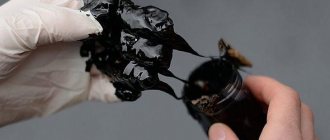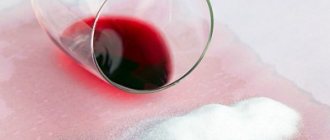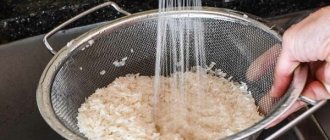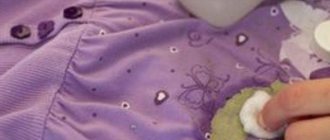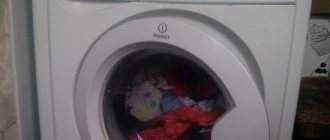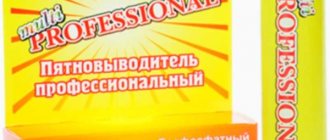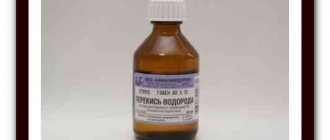Rules and recommendations for washing
Before proceeding directly to washing, it is necessary to mechanically clean your item of clothing from dust, sand or other visible contaminants. This will greatly simplify subsequent work and allow you to wash the material efficiently.
It is also recommended to take into account the following nuances:
- You should wear a pair of socks for no more than one day, since the dirt has not yet had time to eat into the fabric and is much easier to get rid of.
- White socks should be washed separately from other laundry, especially colored ones.
- Before putting socks into the machine drum or washing them by hand, it is recommended to thoroughly rub them with soap and leave them in water for several hours.
- Heavily soiled laundry should not be washed in very hot water, because in this case the dirt will eat into the fabric even more.
- Turn your socks inside out before putting them in the washing machine.
We use pharmaceutical chemicals
To whiten socks, you don’t have to buy special household chemicals. You can resort to “folk” remedies that are less expensive, but no less effective. When trying to wash white fabric, some unexpected home remedies can help.
- Turpentine. The cleaning method is extremely simple: you need to fill a basin with 3 liters of water heated to no more than 40°C, dissolve 60-80 grams of dry washing powder in it and pour in 15 ml of turpentine. Dirty socks are immersed in the resulting solution and left to soak overnight. In the morning they need to be rinsed well and dried.
- Aspirin. Six tablets need to be finely crushed, the resulting powder should be diluted in a liter of water. Things are soaked in the solution for nine hours, then rinsed.
- Soda. This well-known substance will be a good helper in automatic washing. A handful of soda is poured into the cuvette, along with the main detergent. Socks are washed on a two-hour cycle with a water heating temperature of no more than 40°C.
- Mustard powder. Powdered mustard must be diluted with water to the consistency of sour cream, then applied to the most contaminated areas. The socks are left in this position for a couple of hours until the “mush” dries out. Afterwards, the products are washed in clean water by hand using laundry soap.
- Lemon juice. Select 3 ripe lemons, about 20 seconds. heat them in the microwave, squeeze out all the juice and dilute it in a liter of water. The socks are soaked in this solution for 6 hours. Citric acid is an effective natural bleach that helps quickly remove tough stains.
- Acetic acid. Four tablespoons of 9% vinegar are diluted in two liters of water heated to 40°C. You need to immerse socks in this solution, cover the bowl with polyethylene on top so that the vapors of the substance do not evaporate, and leave for 50-60 minutes. Next, all that remains is to rinse the products.
There are plenty of ways to clean dirty white socks. This can be done either manually or using an automatic machine, using special household chemicals or “folk” remedies.
Interesting:
- How to wash socks correctly
- How to wash wool socks in a washing machine?
- Where do socks go from the washing machine?
- Is it possible to wash panties and socks in the washing machine?
- Sock washing machine
- Washing laces in the washing machine
Reader comments
- Share your opinion - leave a comment
What tools to use
To clean white socks, stockings or tights, you can use both special products and improvised materials that are present in the arsenal of every housewife.
The first include such bleaches as the budget Bos Plus Maximum or the more expensive Astonish OXY PLUS. Laundry soap with a whitening effect copes well with stubborn stains.
If you don’t have a branded stain remover on hand, you can make your own at home. To do this you will need substances such as:
- lemon juice;
- boric acid;
- hydrogen peroxide;
- table vinegar;
- ammonia.
However, before choosing the appropriate composition, you will need to determine what material your product is made of. The washing method will directly depend on this.
Preparation for the process
Before you start washing your socks, you should prepare them:
- sorted by color and type of material;
- cleaned of dust and particles of dirt, for which they turn it inside out and shake it;
- select the appropriate detergent.
To improve the quality of subsequent washing, it is recommended to pre-soak light-colored socks.
For this, both regular washing powders for white laundry and solutions from improvised products are suitable:
- boric acid,
- vinegar,
- laundry soap,
- ammonia,
- peroxide.
The basin is half filled with warm water (no more than 30 °C) and the selected product is mixed into it . Then the laundry is immersed there and left for at least 3 hours (if it is very dirty, it can be longer). After this, you can start washing.
To correctly determine the method of washing socks, do not throw away the tags from new pairs. They usually contain important information about the product and care instructions from the manufacturer.
How to wash white socks from different types of fabric at home
Cotton
To bleach cotton socks at home, you are allowed to resort to boiling, which is strictly prohibited from doing with things made of synthetics or wool.
Soaking cotton products can be done using the following components:
- Table vinegar. Take 1 teaspoon of vinegar and dilute it in 1 liter of plain water. Soak in the resulting liquid for 30 minutes, then wash by hand or in a washing machine. To enhance the effect, the liquid can be heated to 40 degrees, and you can also add a small spoon of citric acid or a drop of detergent to it.
- Boric acid. This medicine is well known for its whitening properties. For proper use, you need to mix 1 tablespoon of acid in 1 liter of warm water. After 2 hours, clothes must be washed by hand or machine.
- Ammonia. Pour two tablespoons of ammonia into a container containing 1 liter of water. Soak the item of clothing in it for 2-3 hours, then rinse thoroughly and wash in a machine or by hand.
Synthetic
Synthetics require more delicate handling. It is recommended to remove stains with the following substances:
- Laundry soap. Rub the stained areas thoroughly with soap and a small amount of water. Products can be left in a soap solution from half an hour to a day, depending on the degree of contamination. After soaking, rinse and dry them.
- Lemon juice. To prepare the cleansing mixture, you need to squeeze one tablespoon of juice from a ripe fruit, add it to warm water and place the laundry there for 30-60 minutes. After this, you will need to rinse them and wash them in any convenient way. If this procedure does not help to completely clean the laundry, you need to apply lemon juice, sprinkle the powder on the contaminated areas and rub them. After this, you need to wash your clothes again.
Woolen
Wool socks also require special care. They should not be washed in hot water or rubbed vigorously. This may cause the product to lose shape and stretch.
To wash white wool socks, you can use the following substances:
- Baking soda. Add a pinch of baking soda to a basin of slightly warm water. Soak the products in the resulting solution for 2-3 hours, then wash them with your hands. When using a washing machine, you can also pour one tablespoon of soda into the rinse aid compartment. It is worth remembering that when express washing wool in a machine, you need to choose a mode with a low temperature of up to 40 degrees.
- Hydrogen peroxide. This gentle product does an excellent job of bleaching woolen items. When preparing the solution, the following proportions must be taken into account: 1 tablespoon per 1 liter of water. Leave the socks in the solution for several hours and then wash them.
Important. When using special equipment. It is recommended to protect your hands from their negative effects with gloves.
Make your own bleach at home
- Mix three tablespoons of hydrogen peroxide with one spoon of ammonia. Add the resulting contents to three liters of heated water. Socks are soaked in this bleach for the whole day and then washed.
- For white socks with colored patterns, we will prepare a stain remover. Take some toothpaste and mix it with hydrogen peroxide. Apply the product only to the stains for a few minutes. There will be no stains left after rinsing. In both cases, we pre-wash the socks with laundry soap to get rid of excess dirt.
- Regular vinegar will work too. Dilute a glass of vinegar in one and a half liters of water and boil the contents. Leave the socks in the solution for up to ten hours, then wash as usual.
- Light and fresh stains can be removed using any dish soap. Apply it to the stain for about thirty minutes, then wash and dry.
- If none of the methods help, and you don’t want to throw away your socks, citric acid or lemon juice is the most powerful and effective remedy. Mix one of the ingredients with baking soda, add it to cold water and bleach for thirty minutes before washing. The socks will become clean and white.
As you can see, there are quite a lot of ways. White things need proper care. Do not store socks with other dirty laundry for a long time. Don't forget to pre-soak and bleach. And your socks will always look perfect. If it is impossible to wash, buy new ones, these are just socks.
Removing paint from shoes
Often, the main problem that lovers of light-colored clothing encounter is the dyeing insole of their shoes.
Even after several hours of wearing, we are saddened to admit the fact that our favorite socks have turned dark due to low-quality shoe dyes. In this case, do not despair, because there are a number of effective methods on how to wash white socks from dirt.
For cotton items, bleach containing chlorine is ideal. For these purposes, you can safely use Domestos or any other similar special product containing chlorine.
Dilute Domestos with water in proportions of 1 to 1 and apply the resulting solution using a cotton swab to problem areas.
It is worth remembering that chlorine is a potent substance, and therefore it is forbidden to leave it on things for a long time.
After soaking, it must be thoroughly rinsed and washed.
For woolen and synthetic products, you can use pure juice obtained from lemon. It is enough to squeeze a few drops onto the contaminated material and wait 10-15 minutes, then wash it.
If the result is not satisfactory, you can use peroxide.
To effectively wash white socks from black soles, the concentration of peroxide can be doubled.
Thus, you will need to dilute 2 tablespoons of the product per 1 liter of water and keep the items in it for 10-15 minutes, then rinse in warm water.
To remove stubborn dirt from the soles, you can use a combination of sodium percarbonate and dishwashing detergent.
After mixing these mixtures in equal proportions, add a little water and apply the resulting mixture to areas that cannot be washed. After about an hour, wash the socks by hand. This method usually does a great job of restoring clothes to their original appearance.
How to boil correctly so as not to spoil the thing
The outdated boiling procedure is considered aggressive to materials and is used in extreme cases. If you cannot do without such processing, remember:
- Only thick cotton socks can be boiled;
- It is better to load wardrobe items into enamel pans or stainless steel containers;
- Dishes must be selected at the rate of 10 liters of water per 1 kg of laundry.
Dirty socks are pre-soaked in a suitable solution. After a specified period of time, take it out, squeeze it out and put it in a pan with water and detergent. As the latter, use a mixture of 2 tbsp. l. ammonia and powder, grated laundry soap or a small amount of White, diluted according to the instructions on the package.
Boil socks for 2-4 hours. To speed up the process, you can put a glass bowl with water, lemon juice and laundry in the microwave for 10-20 minutes. Just make sure that the liquid completely covers the fabric and does not evaporate below this level.
Important! Only white socks made of cotton, linen or bamboo can be boiled. Synthetic and wool products must not be processed using this method.
Removing gray spots and yellowness
As a result of frequent washing, light-colored items tend to darken and lose their former appearance. In this case, do not rush to throw away your socks.
There are several miraculous ways to help restore your snow-white appearance:
- Severely grayed items can be bleached using turpentine. Take 3 tablespoons of liquid with a pungent odor and dilute it in a 10-liter bucket of water, adding a few tablespoons of regular washing powder. After thoroughly stirring, leave the items in the resulting mixture overnight, then wash as usual.
- Chlorine-containing products also do an excellent job of removing gray spots and yellow discoloration. However, they can only be used on clothing items made of cotton. Pour 2 tablespoons of liquid into 2 liters of water and add 100 grams of washing powder. After thoroughly mixing the mixture, leave the clothes in it for one night, then wash them.
- You can make a stain remover at home using hydrogen peroxide and ammonia. To do this, mix the ingredients in proportions of 1 to 2 and apply the mixture to problem areas.
- Another bleaching method is to use a mixture of laundry detergent and dishwashing detergent. To prepare it, you need to squeeze out a few drops of washing liquid into one tablespoon of powder and foam it. Apply the solution directly to stubborn stains and wash with your hands after 10-15 minutes.
- An equally effective way to return things to a presentable appearance is to use special stain removers. A wide range of store-bought products offer many different ingredients for whitening items. When using stain removers, it is recommended to follow the instructions exactly to avoid unforeseen situations.
Please note that it is advisable to dry things away from sunlight. Otherwise, the yellowness may return and it will no longer be possible to remove it.
The best option would be to dry it outside in the shade, which will also help rid things of a specific smell.
Important. When using special chemicals, it is recommended to limit the time they remain on the fabric to a minimum. Otherwise, damage to the fiber structure may occur.
We return whiteness to products without boiling
Removing stains from white clothes is not difficult for men either. They came up with a very unusual method especially for them.
How to wash socks from dirt and how to bleach them:
- A plastic bottle (5–6 l) with a wide neck is filled with soap solution.
- Place white socks through the neck and close the lid tightly.
- They put the container in the trunk and go about their business.
This method is recommended for use in extreme cases. Boiling white socks is justified if the products have deep, ingrained dirt. It is also recommended to boil things in cases where they have lost their whiteness.
White hosiery should be boiled to disinfect it. This applies to cases where things have been in contact with a source of bacteria and viruses for a long time.
Boiling is the only option for removing dirt from white socks if a person is allergic to chemicals or homemade laundry products.
It is recommended to boil hosiery according to the following scheme:
- Take an enamel or stainless steel pan and pour 2 liters of water into it.
- Load laundry into it.
- Add your choice of either 30 g of grated laundry soap, or a mixture based on 110 g of washing powder and two large spoons of bleach. You can use a mixture based on 35 ml of ammonia and 160 g of soda.
- Place the container on medium heat.
- After the solution with the laundry boils, reduce the heat and simmer for 15 minutes. For severe stains, you can boil things for half an hour.
- During the process of boiling hosiery, it is necessary to periodically turn them over with special tongs.
- After boiling, things are rinsed.
After pre-washing, proceed to the bleaching procedure. Without boiling, three categories of products cope well with this task:
- purchased chemicals (bleaches and stain removers);
- natural brighteners;
- pharmaceutical drugs.
The original color of the socks is returned in two ways: locally, by applying the brightener directly to the poorly washed area, and by soaking in a bleaching aqueous solution.
Soaking with brightener is used in cases where socks have become yellowish or gray after repeated washing.
If you decide to use a chemical product, then the choice should be made in favor of oxygen bleach. Its advantages:
- Versatility. Suitable for items made from any fabric.
- Soda and peroxide, into which it breaks down in water, do not damage the fibers, so the product is suitable for constant use.
- Removes both fresh and stubborn dirt and stains from white socks.
Chlorine brighteners, for example: “Domestos”, “Belizna”, also return the white color to socks, but not for all. Only products made of cotton, bamboo and linen can withstand the action of aggressive substances. Chlorine is contraindicated for synthetic fabrics. In addition, chlorine-containing products are used only for soaking and hand washing. It is prohibited to add them to the machine.
Chemical brighteners should not be used to wash children's clothes. They can cause allergies.
Boiling
Once upon a time, boiling was almost the only way for housewives to clean light-colored clothes from stubborn dirt.
Currently, it is one of the methods that is resorted to in the most extreme cases. In order for boiling to give the desired result, you need to follow simple rules:
- Only cotton clothing items are allowed to be boiled.
- It is recommended to boil in enamel containers or stainless steel vessels.
- For every kilogram of things you will need about 10 liters of liquid.
- The detergent component must be thoroughly dissolved.
- The container should only be heated after loading laundry.
- Before boiling, it is advisable to soak in a similar solution to enhance the effect.
How to wash white socks by hand
To wash light-colored socks at home, many housewives prefer hand washing. This method is often effective and helps get rid of contaminants.
It is recommended to clean cotton material in hot water, while for synthetics and wool the temperature should not exceed 40 degrees.
To clean cotton and wool fabrics, you can use soap products and washing powders. It is better to wash synthetics using BIO powders with enzymes and special gels.
Whitening using household chemicals
To care for white socks, it is better to use products with bleaching ingredients. In this case, it is better to opt for less aggressive substances.
Available products with bleaching ingredients will help you whiten white socks.
- Laundry soap. This is what every housewife has on the bathroom shelf. You need to take real laundry soap, where 72% is indicated. It is brown in color and has a not very pleasant smell, but it whitens well. They are very convenient for hand washing white socks. Rub it on a soiled, damp item and let it soak for a couple of hours. Then you can start washing.
- White. This is an inexpensive product, but it removes stains with a bang. Total bleaching is a last resort. It must be remembered that a high concentration of whiteness can give a white item a yellowish tint, or even completely destroy the structure of the fabric. But if there is no other option, then prepare a weak bleach solution and soak according to the instructions on the package.
- Stain removers. You can use products like “Vanish”. They are designed specifically to remove complex stains and if you follow the instructions, you can save even a badly damaged item.
- Dishwashing liquid. The usual “Fairy” and other types of these detergents know how to whiten socks at home. If the pollution is not severe, this is what you need. Apply the substance to the stain, leave for half an hour, then wash the product.
How to machine wash white socks
Often, a washing machine cannot guarantee a 100% result in cleaning clothes from stubborn dirt.
Even a special “white” mode does not always help with high-quality washing. But don’t get upset ahead of time, because in this situation there are several secrets that will make the task easier.
- Before throwing your socks into the drum of the washing machine, soak them for a certain time using the method described above. If your machine has a pre-wash option or a soak mode, use them.
- Turn your socks inside out. This will help remove dirt from the fabric structure faster.
- To enhance the effect, place special balls or regular tennis balls in the drum of the machine, which will knock out stubborn dirt.
- When washing cotton and synthetic linen, you can use conventional automatic washing powders. For wool, it is recommended to choose special powders that do not disturb the wool fibers.
- Pour the previously prepared soda solution into the rinse aid compartment. You can prepare it by stirring 1 teaspoon of baking soda in a glass of water. This way you can return the white color to faded items.
Do you know why you dream of doing laundry in a dream?
Features depending on the fabric (cotton, synthetics, wool)
To understand how to wash socks, you need to decide on the type of material from which they are made.
It's easier to find out by reading the tag. If this is not possible, then they are determined by touch. Thus, woolen and synthetic products require a more careful approach than cotton ones . Soak them briefly and wash them at 40°C, preferably by hand. For synthetics it is better to take washing powder, for wool - gel.
To prevent pilling from appearing on woolen socks, they should be washed in a machine with the addition of conditioner and on a delicate cycle.
Cotton products can be boiled . To do this, add washing powder and a couple of lemon slices to boiling water. Then put the socks there and boil them for a quarter of an hour. Afterwards, all that remains is rinsing.
How to keep socks white
In order for them to always be white, it is enough to follow a number of simple rules:
- Make sure your feet are clean before putting them on. A dirty foot can stain the fabric no less than external influences in the form of dirt or sand.
- Avoid wearing socks with dark shoe insoles. When exposed to moisture, it colors the fibers, and the paint settles firmly inside.
- Try not to wear underwear for more than one day, and wash them immediately afterwards.
- Before washing, soak your laundry using one of the tips above. Pre-soaking often eliminates further manipulation.
- Pay attention to the label and composition of the material. Wool, synthetics, and cotton require different care methods.
- Wash light-colored fabrics separately from colored ones. Even faded colors can leave pigment on light-colored fabrics.
- Follow the washing schedule. Cotton and synthetic fabrics are washed at a maximum temperature of 40 degrees.
- Products treated with acid for bleaching must be dried in fresh air, avoiding exposure to ultraviolet radiation. The sun's rays leave bright yellow spots, which are almost impossible to get rid of in the future.
Share what whitening methods you use in the comments. Don't forget to join us on social networks and share the article with your friends.
Special car wash
You decided to remember this washing method at the very end, but you still can’t ignore it, because this washing method is suitable for most men. You need to put your socks in a regular water bottle, pour washing powder and other bleaching agents into it, pour water, but leave a small amount of air. Cork and throw in the trunk for the whole day of travel. Within a day of dangling in the bottle, your socks will be the perfect white color. And you don't have to put in a lot of effort to get these results.
